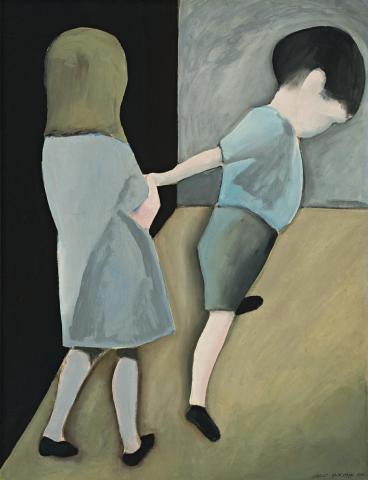CHILDREN, 1954-56
Charles Blackman
oil and enamel on composition board
97.0 x 74.0 cm
signed and dated lower right: CHARLES BLACKMAN 1956
Private collection, Melbourne
Deutscher~Mentzies, Sydney, 18 March 2008, lot 44
Private collection, Sydney
Charles Blackman's schoolgirl series of paintings, when shown in his first solo exhibition at the Peter Bray Gallery in 1953, introduced a singular new talent to the Australian art world. Alan McCulloch, art critic for the Melbourne Herald hailed them as 'at once exciting and extremely stimulating.'1 Acknowledging 'Blackman's great potentialities', he referred to the autobiographical side of all 'meaningful art', and observed that'in this case the artist has projected his personality, with all the hopes and frustrations, into the extremely difficult subject of the schoolgirl.' The artist and the series became part of art history, as Blackman continued to explore themes associated with the wonderment of childhood, its joys and fears, before launching into the fantasy world of his Alice in Wonderland paintings. Children, 1954 - 56, belongs to this exciting period, when, with sharper eye and edge, he delved further into the world he had introduced as seen through the eyes of children.2 Both in imagery and technique, starkness and isolation were taken to a higher level, employed as metaphors of the emotional state of the young boy and girl. Starkness of forms and palette gave added edge to the feelings of isolation and loneliness. The size of the figures filled so much of the picture area that they expressed that feeling of awkwardness that comes from being obvious. They are so confined that an inner tension is built up by the proximity of heads and feet to the picture's borders. The action of the boy speaks of that frustration that leads to the pointless action of hitting one's head against a brick wall.
Moreover, abrupt angles meeting at the composition's centre emphasise the division between the two and the nature of what upsets them. The tug of one against the other, within conflict and uncertainty, can be translated as seeking escape from the strong hold of reality. As in many of the schoolgirls series, faces are hidden. Paradoxically the setting seems empty despite the large presence of the figures; and there are no doors or windows of refuge. Even shadows are banished, an eerie, surreal touch we associate with the best of Alfred Hitchcock. Blackman engages simplicity of form and colour as a clever device to give impact to his exploration of deeply moving, complex emotional and psychological states. Colours are metaphors of moods - of blue, grey, black. One can only speculate on the autobiographical references the painting contains; and why loneliness held the twenty-six-year-old artist in its thrall. It is, of course, part of the human condition, which Blackman chose to present through the everyman in the guise of childhood.
1. McCulloch, A, 'Quantity - And Quality', Herald, Melbourne, 12 May 1953, p. 10
2. Although the painting is dated '1956', technique and imagery suggest an earlier date of 1954. Felicity Moore (Charles Blackman: Schoolgirls and Angels, National Gallery of Victoria, Melbourne, 1993, p. 18) tells us that in 1954 Blackman was experimenting with an 'oil-based yacht enamel, predominantly black'. Its use is also found in the stylistically and thematically similar painting, Running Boy, Walking Girl, dated 1954, in the collection of the Newcastle Region Art Gallery.
DAVID THOMAS
